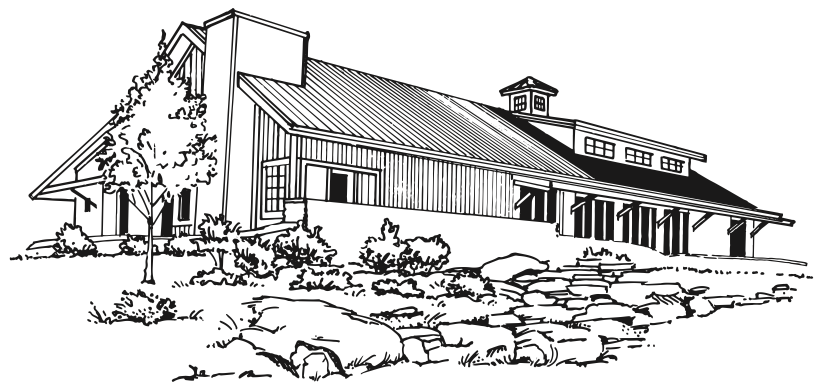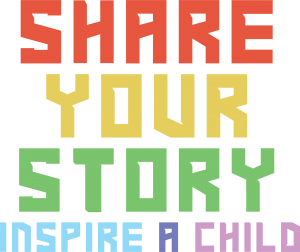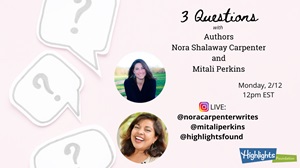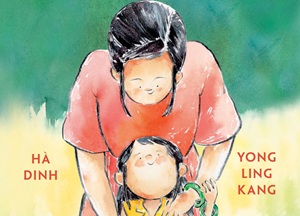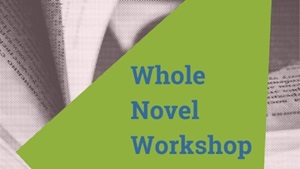Faculty members Nora Shalaway Carpenter and Mitali Perkins joined Highlights Foundation Social Media Manager Cat Galeano on Instagram Live to talk about their upcoming mini-course Talk to Me: the Ins and Outs of Dialogue that Drives Plot and Delivers Reader Satisfaction.
Watch the conversation below. (Please note: closed captions are being added to the video below. When they are finished, you can see them by hovering over the bottom of the video and choosing the “CC” icon.)
Full Transcript:
Cat:
So we’re going to just jump into it and a big hello to our Highlights Foundation family. We’re so happy to have you here with us! For those that may not know me, I’m Cat Galiano and I’m the social media manager for the Highlights Foundation AKA the person that always responds to all your shares and your comments. So yes, that’s me. And I’m joining you from Westchester, New York on the traditional lands of the Siwanoy people. For those that may not know, I’m also a writer, but also a reader, so I am very, very, very excited to have this lunchtime chat with our friends and faculty Nora Shalaway Carpenter and Mitali Perkins, who will be teaching the upcoming mini Talk to Me: the Ins and Outs of Dialogue that Drives Plot and Delivers Reader Satisfaction.
It is quite a mouthful of a title, but I think it says everything that, you know, we need to know about it. So we’re going to just dive a little bit and give people a little preview of what to expect for the class because we can’t give away all the good things. That’s why you have to join us. But we’re going to give just a small sampling. So my first question for both of you is: I love this topic for the webinar and dialogue can do so much in a story. So first I wanted to start with what is a memorable piece of dialogue that you didn’t write that you really thought brought the story or the novel that you were reading to life.
Nora:
Ah, I’ll go ahead and jump in here. And so I’m not actually sure that I’m going to use this in the presentation. But it’s it’s so good. So I’m going to talk about it anyway. It’s, these are actually this is actually an adult, a novel for adults, but it really doesn’t matter. You can, I think you should study all different, all different kinds of works. So in Richard Osman’s The Last Devil to Die, which–I think all of his Thursday Murder Clubs books–I think have incredible dialogue and really, really bring all four of his main characters to life. But there is this wonderful scene in which the four main characters are are sitting with two very important secondary characters in a funeral service and they’re having an important conversation and it makes sense if you read the book why that, why that’s happening, but anyway it’s like interspersed between, you know, you hear what’s happening from the priest who’s leading the the service. And then you hear the snippets of dialogue and then they respond to each other. And it is like so funny. And so, like, you’re like in the moment and I just think it shows such great like. How do you beat really well and also how it brings each individual character to life. So that’s what I wanted to highlight for that question.
Mitali:
Oh wow, you made me want to read it.
Nora:
So good, everyone should.
Well, that was the first one though.
Mitali:
OK. Well, hello to all of you. And I love seeing you Cat, talking to you. I know that if I post something on Instagram and I don’t get a little “My auntie’s so cute” Or, “I love my auntie”, it feels like it wasn’t a successful post. So anyway, I’m going to throw back [holding up a copy of Little Women] Here we are, my tattered…I just wrote about this so, and I have it memorized: “Christmas, won’t be Christmas without any presents,” said Jo,laying on the rug (I know that that’s the first line)and then Meg says–actually she grumbles–“Christmas will be Christmas without any presents”, grumbled Jo, lying on the rug. “It’s so dreadful to be poor,” sighed Meg, looking down at her old dress. “I don’t think it’s fair for some girls to have plenty of pretty things and other girls nothing at all” said little Amy, with an injured sniff. “We’ve got father and mother and each other,” said Beth contentedly from a corner.
Alright, so I really love the beginning because it’s four sisters. Each thing they say is so distinctive to their characters, to their growth, their narrative arc, and we can just see them sitting by the fire. And what I love about that piece of dialogue is it’s something that we’re going to work on in the webinar is this idea that each character should say something very distinctive, both to their to their narrative arc, to their character arc. Because all four of these characters are going to change through the story. We had a glimpse of what they want from each of those pieces of snippets of dialogue. And so they it serves the the plot and also they’re distinctive in that they serve to characterize, right?
So we also get a sense of place and that’s what I love about dialogue. It’s in the moment, and if you can write it well, each character says something that only they would say in that moment of time, in that trajectory of action and change in their lives and that befits their own voice and character. So I just love it so much. It’s such a powerful tool. We’re gonna have fun. Nerding out over particular nouns and verbs and and you know what to do with taglines and how to you know and just, this is a place where writing nerds like us can really geek out with the, with the tools of our trade. Which, which are words.
Cat:
I wanted to – Oh, I’m sorry Nora…
Nora:
Well I was just going to say that Mitali hit on something that’s like a really big theme, obviously, of the webinar is that dialogue does so many things. A great dialogue does way more than one thing as it’s being written and another thing that I just wanted to comment on real quick is because we are going to be talking about the difference between like real dialogue that you’re going to hear from your friends or you know, sometimes I get like feedback, like if I’m getting feedback on writers and people will be like well: “I’ve heard people say that, that’s how they talk in real life.” And so yes, that’s true. But there is a big difference between the dialogue that we want to put in our fiction and the dialogue that is in real life. And we’ll talk about why that is and the different types.
Cat:
I just wanted to say, just like from a, a nerdy reader perspective, like just the magic that dialogue can do in a story. Like honestly sometimes; I don’t have the book with me and I’m just like, oh, I wish I could just run over to my bookshelf and grab it. But there’s one book that has stayed with me for a long time. It’s Where She Went by Gayle Forman and just the short, how short that book is. I think it’s 120 pages and just like the WORDS! I I I read that book over a decade ago and I still think about it at least once a week. And I’m like, wow, she really did that, like dialogue really can do that, so I find it like so exciting that this class is going to happen, this webinar that both of you are going to talk about it fromlike the reader perspective, from the writer perspective. So uh, I can’t wait to watch it, so I will be tuning in and I hope all of you sign up too–just a little plug. But we’re going to jump into our second question, which is basically I’m going to ask you the same question, but about your own work. Can you tell us about a favorite or crucial piece of dialogue in one of your own novels and what it unlocked in your story? Or maybe what you thought it would help unlock for your readers.
Mitali:
Shall I’ll go first, Nora? Go ahead.
Nora:
You can go. I went first on the first one.
Mitali:
All right, well as you guys know, I’m drawn into this wonderful webinar at the last minute. I just got back from a writer;s conference in Big Sur with the my literary agency, Andrea Brown Literary Agency. And so I’m going off the seat of my pants here, but I do, I do remember there’s always one line in one of my stories that not only does it reflect the characters and the interaction and the plot, but it comes deeply out of my own life and my own art. It’s a it’s a line of dialogue that, that has spurred me on in my own quest which is why I was remember it. It’s in Rickshaw Girl, and the character Naima, like me, is, is a daughter in a son-less family, in the Bengali family. And of course, in our culture, having no sons is quite the shameful thing in the village. And so, you know, she’s growing up. She’s hearing a lot about if you’re a boy, you could help your father. If you’re a boy, you could earn money and there’s one place in the story where everybody’s coming after her because she’s not a boy and she can’t contribute economically and the father’s never, ever said that. His entire life he’s been a supporter for her. And so he says, “a daughter is just as good as a son.” And for me, that was, I, I heard that from my dad, so I got to put that line from my own life. It’s kind of the heart of the book, the heart of the story, the blessing she gets from her father that spurs her on to invest in her art.
So I think the reason I, I remember that is because it’s my voice and my life that I that I used to enrich the dialogue. The emotional resonation in my own life. And that’s another thing that we can explore as writers. Like the things that are so meaningful to us, if we put them in the words of our characters, they land in a different way, in a really rich way.
Nora:
And I love that how that one line really is speaks to like the whole theme of the book. You’re like, OK, where’s the book about? It’s in this one line, right? Like that’s that’s really powerful, I love that.
Oh, OK. So we’re also going to be talking a lot about subtext in, with dialogue in the webinar and so I, I like, as a reader, I just can’t get enough of like some of, you know, dialogue that you’re like, oh, there’s more going on here. I can tell. It’s just like exciting when you can be like oh, I can figure it out, you know. So one of the, in my my first, in my debut novel The Edge of Anything, a scene that I, I’ve always really loved and which sticks with me is when it’s between two best friends and they’re having this moment where the main character, she has just found out that she has a serious heart condition and she can no longer do the thing that she loves to do and her…but she’s keeping this from her best friend because she is like, she has kind of this irrational hope that she’s somehow gonna be able to get back to that position. And then so she so her friend is trying to get this out of her and she’s shut her down. So then her friend is telling her, Hey, well I have some news and then it’s awesome news about the same sport, right? That the friend can no longer play, and so the reaction of the main character to hearing like that her best friend is actually doing the thing that she wanted to do, and now will probably never be able to… You know, she does not say like Oh, that’s terrible, you know or but and and. And she’s so conflicted because, like, she wants to feel good for her friend–it’s her best friend. You know, like she wants to be a good friend. But she also has just this horrible, horrible feeling of jealousy and despair, because that can never be her reality.
And so I was actually looking at the scene like when you sent those preview questions, Cat, and I was like, Oh my gosh, there’s actually not a lot of dialogue here like, like, because like you get like her inner like, there’s so many like internal beats. And so it’s really interesting to look at like the putting the dialogues together without that beat and how it changes. Like how it changes once you have those internal things. So yeah, and I have lots of other examples from other writers that we’re going to be like studying to see because I just like LOVE subtext.
Cat:
Like, isn’t that so cool though? Like where is this so magical? Because like you said, like if you remove the subtext. The the, the, the, the dialogue would not hit. You know, like when you infuse the subtext. And I’m like, ah great words. So cool. Love it. Oh my gosh, I’m like, I cannot wait for this, yeah.
Mitali:
And along with that, there’s those nonverbal beats in the scene that can show. You know, this show the subtext of the emotion. Like whether it be this shrug or the eye roll but you, you’re using it sparingly, but to show that what’s being said actually is contradicting with with what’s being felt.
Nora:
Exactly.
Mitali:
And that’s what’s fun to play with because you can see it in real time. So you can add it, the the beats the the nonverbal beats, which are really fun.
Cat:
That is, uh, so cool. Ohh man, I can’t wait for this class! So my third and final question is: if you’re on the fence about writing some element or part of your story or if it should be dialogue or not, are there any specific steps you take in your creative process to help you figure it out?
Nora:
Well, for me, I think I often, if it’s a really big scene, if it’s an important scene, I almost always put it in dialogue first anyway, just because sometimes I need to figure out like I might actually know what the overall what’s happening, but I need to see like how the characters individually will react to each other and sometimes it surprises me. Sometimes it, it ends up, you know, I’ll end up shortening it a lot, but if it’s more often than I struggle with, like, smaller scenes. I’m like, oh, I don’t know if this should be in dialogue or not? And then I kind of do the opposite. Where I will, you know, chunk it out in exposition and then go back and just be like, Oh, like I think we need to like embrace it a little. You know, like we need to, we need some more meat here.
Mitali:
Yeah, I, I usually start out with dialogue now too. Because I’m one of those writers that, you know, your character, my character will wake up, brush their teeth, comb their air and like, it just takes forever to get to that place where something happens. Like so, but dialogue gets you in that moment. So I usually now what I do is, when I’m mapping out my novel, I’ll pick a place, pick all the different places because of course setting also really…and can contribute to good dialogue, right? There’s some things we say when we’re only in a particular place. So I’ll pick a place, pick who’s in that scene, and then I’ll just start writing the dialogue. And as Nora said: later on, we can cut it. But it gets you in that real time so you’re not dragging along in all the in between moments: “And she tied her shoes” that go on and on. And and I have, you know, it gets you away from that narrative voice that, that tells a lot of back story. So and then you can fill it in later, but it gets you in real time with the characters moving them forward so you don’t have and then later on you could say does it need back story here, and if so where do I put it in? So it’s a great tool to get started when you’re stuck.
Nora:
Absolutely, I agree. And I’ll, sometimes when I’m writing, I don’t know if you do this Mitali, But like I will write the dialogue with just the tags like “he said,” “she said.” And no beats at all. And sometimes I, I’ll feel it and I’ll be like “beat” but I’ll just like move on because I want to get like just to the voice. You know, and that way, like go back and add that and sometimes that, that can be like really eye-opening too because you can be like oh, it took me two pages, but this is actually what I want the characters to say, like this is the part that that needs to be in the book.
Mitali:
Oh my gosh Nora, that’s brilliant. I’m going to try that. That’s awesome.
Cat:
I’m also like ooh! I’m going to go rewatch this after I finish and take that note down.
Mitali:
No, because I love that. Just, just what they said, as if you’re eavesdropping on a real conversation. You’re not, and you’re hearing it all. It’s the audio, right? For separating the audio from the video in your mind. And that’s really good. I’m gonna use that too.
Cat:
We’re getting like nuggets, golden nuggets here, people, so I hope you try to incorporate that into your work, because that is cool. And I definitely want to try that out too.
So our conversation is coming to an end, but honestly, I could sit here and talk with all of you for another 20 minutes if it were up to me. So thank you so much for being with us. And if you’d like to learn more from Nora and Natali, please make sure to sign up for their class Talk to Me: the Ins and Outs of Dialogue that Drives Plot and Delivers Reader Satisfaction, taking place February 27th and 29th. You can register for the webinar on our website at highlightsfoundation.org and lastly you can purchase Nora and Mitali’s books at our virtual book shop powered by bookshop.org. Thank you, Mitali. Thank you, Nora, for joining us today. We cannot wait to see you online.
